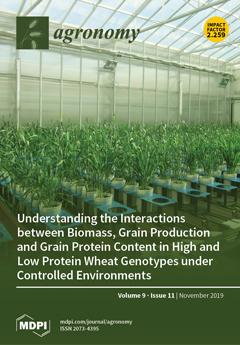The determination of the water requirements and crop coefficient (K
c) of agricultural crops helps to create an appropriate irrigation schedule, and with the effective management of irrigation water. The aim of this research was to estimate the water requirement, K
c, and water-use efficiency (WUE) of potato using non-weighing-type lysimeters in four regions of the Kingdom of Saudi Arabia (Qassiem, Riyadh, Al-Jouf, and Eastern). Our results clearly show that the accumulated values of the measured crop evapotranspiration of potato derived from the lysimeters were 573, 554, 592, and 570 mm, while the accumulated values of the predicted crop evapotranspiration from Penman-Monteith equation based on FAO (Food and Agriculture Organization) were 651, 632, 672, and 647 mm for the Qassiem, Riyadh, Al-Jouf, and Eastern regions, respectively. The K
c values of potato obtained from the lysimeters were K
c initial (0.58, 0.54, 0.50, and 0.52), K
c middle (1.02, 1.05, 1.13, and 1.10), and K
c end (0.73, 0.74, 0.74, and 0.75) for the Qassiem, Riyadh, Al-Jouf, and Eastern regions, respectively. Based on the amount of water used and the yield achieved, the highest WUE (3.6 kg m
−3) was observed in the Riyadh region, while the lowest WUE (1.5 kg m
−3) was observed in the Al-Jouf region.
Full article





